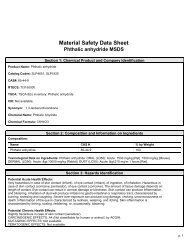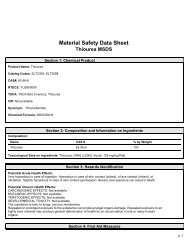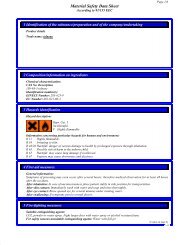You also want an ePaper? Increase the reach of your titles
YUMPU automatically turns print PDFs into web optimized ePapers that Google loves.
Material Safety Data Sheet<br />
Polyvinyl alcohol <strong>MSDS</strong><br />
Section 2: Composition and Information on Ingredients<br />
Composition:<br />
Name CAS # % by Weight<br />
Polyvinyl alcohol 9002-89-5 100<br />
Toxicological Data on Ingredients: Not applicable.<br />
Section 3: Hazards Identification<br />
Potential Acute Health Effects: Slightly hazardous in case of skin contact (irritant), of eye contact (irritant), of ingestion, of<br />
inhalation.<br />
Potential Chronic Health Effects:<br />
CARCINOGENIC EFFECTS: 3 (Not classifiable for human.) by IARC.<br />
MUTAGENIC EFFECTS: Not available.<br />
TERATOGENIC EFFECTS: Not available.<br />
DEVELOPMENTAL TOXICITY: Not available.<br />
Repeated or prolonged exposure is not known to aggravate medical condition.<br />
Section 4: First Aid Measures<br />
Eye Contact:<br />
Check for and remove any contact lenses. In case of contact, immediately flush eyes with plenty of water for at<br />
p. 1
least 15 minutes. Cold water may be used. Get medical attention if irritation occurs.<br />
Skin Contact:<br />
Wash with soap and water. Cover the irritated skin with an emollient. Get medical attention if irritation develops.<br />
Cold water may be used.<br />
Serious Skin Contact: Not available.<br />
Inhalation:<br />
If inhaled, remove to fresh air. If not breathing, give artificial respiration. If breathing is difficult, give oxygen. Get<br />
medical attention.<br />
Serious Inhalation: Not available.<br />
Ingestion:<br />
Do NOT induce vomiting unless directed to do so by medical personnel. Never give anything by mouth to an<br />
unconscious person. Loosen tight clothing such as a collar, tie, belt or waistband. Get medical attention if<br />
symptoms appear.<br />
Serious Ingestion: Not available.<br />
Section 5: Fire and Explosion Data<br />
Flammability of the Product: May be <strong>com</strong>bustible at high temperature.<br />
Auto-Ignition Temperature: Not available.<br />
Flash Points: OPEN CUP: 79°C (174.2°F).<br />
Flammable Limits: Not available.<br />
Products of Combustion: These products are carbon oxides (CO, CO2).<br />
Fire Hazards in Presence of Various Substances:<br />
Flammable in presence of open flames and sparks, of heat.<br />
Non-flammable in presence of shocks.<br />
Explosion Hazards in Presence of Various Substances:<br />
Risks of explosion of the product in presence of mechanical impact: Not available.<br />
Slightly explosive in presence of open flames and sparks.<br />
Fire Fighting Media and Instructions:<br />
SMALL FIRE: Use DRY chemical powder.<br />
LARGE FIRE: Use water spray, fog or foam. Do not use water jet.<br />
Special Remarks on Fire Hazards: Not available.<br />
Special Remarks on Explosion Hazards:<br />
Fine dust dispersed in air in sufficient concentrations, and in the presence of an ignition source is a potential dust<br />
explosion hazard.<br />
Section 6: Accidental Release Measures<br />
Small Spill:<br />
Use appropriate tools to put the spilled solid in a convenient waste disposal container. Finish cleaning by<br />
spreading water on the contaminated surface and dispose of according to local and regional authority<br />
requirements.<br />
Large Spill:<br />
Use a shovel to put the material into a convenient waste disposal container. Finish cleaning by spreading water<br />
p. 2
on the contaminated surface and allow to evacuate through the sanitary system.<br />
Section 7: Handling and Storage<br />
Precautions:<br />
Keep away from heat. Keep away from sources of ignition. Empty containers pose a fire risk, evaporate the<br />
residue under a fume hood. est. Do not breathe dust. If ingested, seek medical advice immediately and show<br />
the container or the label. Keep away from in<strong>com</strong>patibles such as oxidizing agents, metals, acids, alkalis.<br />
Storage: Keep container tightly closed. Keep container in a cool, well-ventilated area.<br />
Section 8: Exposure Controls/Personal Protection<br />
Engineering Controls:<br />
Use process enclosures, local exhaust ventilation, or other engineering controls to keep airborne levels below<br />
re<strong>com</strong>mended exposure limits. If user operations generate dust, fume or mist, use ventilation to keep exposure to<br />
airborne contaminants below the exposure limit.<br />
Personal Protection: Safety glasses. Lab coat. Dust respirator. Be sure to use an approved/certified respirator or equivalent.<br />
Gloves.<br />
Personal Protection in Case of a Large Spill:<br />
Splash goggles. Full suit. Dust respirator. Boots. Gloves. A self contained breathing apparatus should be used<br />
to avoid inhalation of the product. Suggested protective clothing might not be sufficient; consult a specialist<br />
BEFORE handling this product.<br />
Exposure Limits: Not available.<br />
Section 9: Physical and Chemical Properties<br />
Physical state and appearance: Solid. (Powdered solid. Amorphous solid powder.)<br />
Odor: Odorless.<br />
Taste: Not available.<br />
Molecular Weight: (44.05)n g/mole<br />
Color: Off-white. White. Colorless.<br />
pH (1% soln/water): Not available.<br />
Boiling Point: Not available.<br />
Melting Point:<br />
Softens at about 200°C (392°F) with de<strong>com</strong>position.<br />
De<strong>com</strong>position @ 228 deg. C.<br />
Critical Temperature: Not available.<br />
Specific Gravity: 1.19-1.31(Water = 1)<br />
Vapor Pressure: Not applicable.<br />
Vapor Density: Not available.<br />
Volatility: Not available.<br />
Odor Threshold: Not available.<br />
p. 3
Water/Oil Dist. Coeff.: Not available.<br />
Ionicity (in Water): Not available.<br />
Dispersion Properties: See solubility in water.<br />
Solubility:<br />
Soluble in cold water, hot water.<br />
Insoluble in diethyl ether, acetone, petroleum solvents, aromatic hydrocarbons, esters.<br />
Practically insoluble in animal and vegetable oils and chlorinated hydrocarbons.<br />
Stability: The product is stable.<br />
Instability Temperature: Not available.<br />
Section 10: Stability and Reactivity Data<br />
Conditions of Instability: Heat, ignition sources, flame, excess dust generation, in<strong>com</strong>patible materials.<br />
In<strong>com</strong>patibility with various substances: Reactive with oxidizing agents, metals, acids, alkalis.<br />
Corrosivity: Non-corrosive in presence of glass.<br />
Special Remarks on Reactivity:<br />
In<strong>com</strong>patible with oxidizing agents (perchlorates, nitrates, etc.), reactive metals (sodium, calcium, zinc. etc.),<br />
sodium or calcium hypochlorite, materials reactive with hydroxyl <strong>com</strong>pounds. Reaction with peroxides may result<br />
in violent de<strong>com</strong>position of peroxide possibly creating and explosion.<br />
Special Remarks on Corrosivity: Not available.<br />
Polymerization: Will not occur.<br />
Routes of Entry: Inhalation. Ingestion.<br />
Toxicity to Animals:<br />
Acute oral toxicity (LD50): 14700 mg/kg [Mouse].<br />
Acute oral toxicity (LD50): > 20000 mg/kg [Rat].<br />
Section 11: Toxicological Information<br />
Chronic Effects on Humans: CARCINOGENIC EFFECTS: 3 (Not classifiable for human.) by IARC.<br />
Other Toxic Effects on Humans: Slightly hazardous in case of skin contact (irritant), of ingestion, of inhalation.<br />
Special Remarks on Toxicity to Animals: Not available.<br />
Special Remarks on Chronic Effects on Humans: May cause cancer (tumorigenic) based on animal studies. No human<br />
data found at this time.<br />
Special Remarks on other Toxic Effects on Humans:<br />
Acute Potential Health Effects:<br />
Skin: May cause skin irritation.<br />
Eyes: May cause eye irritation.<br />
Ingestion: May cause gastrointestinal (digestive) tract irritation. May affect behavior/central nervous system<br />
(symptoms may include general depressed activity, altered sleep time, muscle weakness). May also affect blood<br />
and metabolism.<br />
Inhalation: May cause respiratory tract irritation.<br />
Chronic Potential Health Effects:<br />
Inhalation or ingestion for prolonged period of time may affect blood and metabolism, and behavior.<br />
p. 4
May cause cancer (tumorigenic) based on animal studies. No human data found at this time.<br />
Section 12: Ecological Information<br />
Ecotoxicity: Ecotoxicity in water (LC50): 10000 mg/l 96 hours [Bluegill Sunfish]. >40000 mg/l 96 hours [Fatthead Minnow].<br />
BOD5 and COD: Not available.<br />
Products of Biodegradation:<br />
Possibly hazardous short term degradation products are not likely. However, long term degradation products may<br />
arise.<br />
Toxicity of the Products of Biodegradation: The product itself and its products of degradation are not toxic.<br />
Special Remarks on the Products of Biodegradation: Not available.<br />
Section 13: Disposal Considerations<br />
Waste Disposal:<br />
Waste must be disposed of in accordance with federal, state and local environmental<br />
control regulations.<br />
Section 14: Transport Information<br />
DOT Classification: Not a DOT controlled material (United States).<br />
Identification: Not applicable.<br />
Special Provisions for Transport: Not applicable.<br />
Section 15: Other Regulatory Information<br />
Federal and State Regulations: TSCA 8(b) inventory: Polyvinyl alcohol<br />
Other Regulations: Not available.<br />
Other Classifications:<br />
WHMIS (Canada): Not controlled under WHMIS (Canada).<br />
DSCL (EEC):<br />
This product is not classified according<br />
to the EU regulations.<br />
Not applicable.<br />
HMIS (U.S.A.):<br />
Health Hazard: 1<br />
Fire Hazard: 2<br />
Reactivity: 0<br />
Personal Protection: E<br />
National Fire Protection Association (U.S.A.):<br />
Health: 0<br />
p. 5
Flammability: 2<br />
Reactivity: 0<br />
Specific hazard:<br />
Protective Equipment:<br />
Gloves.<br />
Lab coat.<br />
Dust respirator. Be sure to use an<br />
approved/certified respirator or<br />
equivalent.<br />
Safety glasses.














